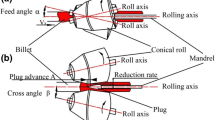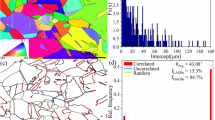Abstract
Since the existing severe plastic deformation (SPD) technology cannot be used to prepare bulk ultrafine-grained material (BUGM) with industry size, a novel method entitled power torsional rolling (PTR), is proposed. The material flow, strain components, strain rate, and temperature were explored by finite element simulation, and the strain-induced grain evolution of pure nickel processed by warm PTR was systematically discussed. The simulation results reveal that the combination of radial compression deformation, longitudinal shear deformation and circumferential shear deformation is beneficial to refine grain size, and the continue local loading characteristic requires less forming load, which confirms that the PTR process has the potential to prepare BUGM with industry size. The experiment results indicate that the grain refinement caused by dynamic recrystallization is remarkable within the temperature range of 450–800 ℃, and the average grain size of pure nickel is refined from 110 μm to 10 μm after two passes PTR. The microstructure distribution of obtained bar is uniform and the isotropic microstructure is observed due to the three-dimensional compression-shear deformation. The tensile test results indicate that the yield strength and ultimate tensile strength increase simultaneously due to the grain-boundary strengthening and twin boundary strengthening.



































Similar content being viewed by others
Data availability
Data available on request from the authors.
Abbreviations
- α :
-
Feed angle
- β :
-
Cross angle
- γ :
-
Cone angle
- T z :
-
Axial component of roll friction force
- P z :
-
Axial component of roll pressure
- F gz :
-
Axial resistance for guide plate
- M T :
-
Driving moments of rolls
- M p :
-
Resistance moments of roll
- M G :
-
Resistance moments of guide plate
- M I :
-
Inertial moments of sample
- T :
-
Roll friction force
- P :
-
Roll pressure
- f :
-
Friction coefficient
- \(\theta\) :
-
Rolling angle
- d z :
-
Average diameter of billet for contacting region
- a :
-
Width of contact region between sample and roll
- P G :
-
Guide plate pressure
- η T :
-
Tangential slip coefficient
- η 0 :
-
Axial slip coefficient
- ε :
-
Reduction rate
- D b :
-
Billet diameter
- D g :
-
Minimum distance between two rolls
- D d :
-
Minimum distance between two guide plates
- Dr :
-
Diameter of rolled bar
- ρ i :
-
Longitudinal shear deformation of any position
- γ i :
-
Circumferential shear deformation of any position
- \(\overline{\rho }\) :
-
Average longitudinal shear angle
- ρ 1, ρ 2 , ρ 3 , ρ 4 , ρ 5 :
-
Longitudinal shear angle of r/R = 0 ~ 0.2, r/R = 0.2 ~ 0.4, r/R = 0.4 ~ 0.6, r/R = 0.6 ~ 0.8 and r/R = 0.8 ~ 1.0
- \(\overline{\gamma }\) :
-
Average circumferential shear angle
- γ 1 , γ 2 , γ 3 , γ 4 , γ 5 :
-
Circumferential shear angle of r/R = 0 ~ 0.2, r/R = 0.2 ~ 0.4, r/R = 0.4 ~ 0.6, r/R = 0.6 ~ 0.8 and r/R = 0.8 ~ 1.0
References
De Cooman BC, Estrin Y, Kim SK. Twinning-induced plasticity (TWIP) steels. Acta Mater. 2018;142:283–362.
Coury FG, Kaufman M, Clarke AJ. Solid-solution strengthening in refractory high entropy alloys. Acta Mater. 2019;175:66–81.
Zhang W, Ma Z, Zhao H, Ren L. Refinement strengthening, second phase strengthening and spinodal microstructure-induced strength-ductility trade-off in a high-entropy alloy. Mater Sci Eng, A. 2022;847: 143343.
Huo P, Zhao Z, Du W, Zhang Z, Bai P, Tie D. Deformation strengthening mechanism of in situ TiC/TC4 alloy nanocomposites produced by selective laser melting. Compos B Eng. 2021;225: 109305.
Gao T, Liu L, Zhao K, Liu S, Han M, Liu G, et al. Design and fabrication of a (6.4γ–Al2O3 + 18Al13Fe4)/Al (wt.%) composite utilizing fine grain strengthening and dispersion strengthening at elevated temperatures. Mater Des. 2022;215: 110432.
Wang X, Shi X, Hui Y, Chen B, Gan B, Shen J. Mechanical behavior and strengthening mechanism of a fine-grained medium carbon steel produced via cyclic oil quenching. Mater Sci Eng, A. 2023;866: 144669.
Ke R, Hu C, Zhong M, Wan X, Wu K. Grain refinement strengthening mechanism of an austenitic stainless steel: critically analyze the impacts of grain interior and grain boundary. J Market Res. 2022;17:2999–3012.
Wang X, Ma Y, Meng B, Wan M. Effect of equal-channel angular pressing on microstructural evolution, mechanical property and biodegradability of an ultrafine-grained zinc alloy. Mater Sci Eng, A. 2021;824: 141857.
Ovid’Ko IA, Valiev RZ, Zhu YT. Review on superior strength and enhanced ductility of metallic nanomaterials. Prog Mater Sci. 2018;94:462–540.
Zhang Z, Zhang J, Wang J, Li Z, Xie J, Liu S, et al. Toward the development of Mg alloys with simultaneously improved strength and ductility by refining grain size via the deformation process. Int J Miner Metall Mater. 2021;28:30–45.
Wang Y, Yang T, Lu Q, Li K, Wang Z, Du Y. Grain size refinement and enhanced precipitation strengthening in a hot extruded 6xxx Al alloy without homogenization. Mater Charact. 2023;198: 112718.
Embury JD, Fisher RM. The structure and properties of drawn pearlite. Acta Metall. 1966;14:147–59.
Yu Z, Tang A, Wang Q, Gao Z, He J, She J, et al. High strength and superior ductility of an ultra-fine grained magnesium–manganese alloy. Mater Sci Eng, A. 2015;648:202–7.
Wang Y, Chen M, Zhou F, Ma E. High tensile ductility in a nanostructured metal. Nature. 2002;419:912.
Straumal BB, Kulagin R, Klinger L, Rabkin E, Straumal PB, Kogtenkova OA, et al. Structure refinement and fragmentation of precipitates under severe plastic deformation: A review. Materials. 2022;15:601.
Tayyebi M, Alizadeh M. Thermal and wear properties of Al/Cu functionally graded metal matrix composite produced by severe plastic deformation method. J Manuf Process. 2023;85:515–26.
Zeisl S, Lassnig A, Hohenwarter A, Mendez-Martin F. Precipitation behavior of a Co-free Fe-Ni-Cr-Mo-Ti-Al maraging steel after severe plastic deformation. Mater Sci Eng, A. 2022;833: 142416.
Korznikova EA, Mironov SYu, Korznikov AV, Zhilyaev AP, Langdon TG. Microstructural evolution and electro-resistivity in HPT nickel. Mater Sci Eng A. 2012;556:437–45.
Yusuf SM, Chen Y, Yang S, Gao N. Microstructural evolution and strengthening of selective laser melted 316L stainless steel processed by high-pressure torsion. Mater Charact. 2020;159: 110012.
Yilmazer H, Niinomi M, Nakai M, Cho K, Hieda J, Todaka Y, et al. Mechanical properties of a medical β-type titanium alloy with specific microstructural evolution through high-pressure torsion. Mater Sci Eng C Mater Biol Appl. 2013;33:2499–507.
Segal VM. Deformation mode and plastic flow in ultra fine grained metals. Mater Sci Eng, A. 2005;406:205–16.
Phan TQ, Lee I-F, Levine LE, Tischler JZ, Huang Y, Fox AG, et al. X-ray microbeam measurements of long-range internal stresses in commercial-purity aluminum processed by multiple passes of equal-channel angular pressing. Scr Mater. 2014;93:48–51.
Wang H, Ban C, Zhao N, Kang Y, Qin T, Liu S, et al. Enhanced strength and ductility of nano-grained titanium processed by two-step severe plastic deformation. Mater Lett. 2020;266:127485.
Böhme M, Wagner MF-X. On the correlation of shear band formation and texture evolution in α-brass during accumulative roll bonding. Scr Mater. 2018;154:172–5.
Fattah-Alhosseini A, Imantalab O. Effect of accumulative roll bonding process on the electrochemical behavior of pure copper. J Alloys Compd. 2015;632:48–52.
Bézi Z, Krállics G, El-Tahawy M, Pekker P, Gubicza J. Processing of ultrafine-grained titanium with high strength and good ductility by a combination of multiple forging and rolling. Mater Sci Eng, A. 2017;688:210–7.
Yuan-Zhi WU, Yan HG, Zhu SQ, Chen JH, Liu XL, Liu AM. Homogeneity of microstructure and mechanical properties of ZK60 magnesium alloys fabricated by high strain rate triaxial-forging. Chin J Nonferrous Metals. 2014;24:310–6.
Morris DG, Muñoz-Morris MA. High creep strength, dispersion-strengthened iron aluminide prepared by multidirectional high-strain forging. Acta Mater. 2010;58:6080–9.
Zhang Z, Liu D, Man T, Li N, Yang Y, Pang Y, et al. Numerical and experimental investigations on Mannesmann effect of nickel-based superalloy. Archives of Civil and Mechanical Engineering. 2022;22:133.
Yamane K, Shimoda K, Kuroda K, Kajikawa S, Kuboki T. A new ductile fracture criterion for skew rolling and its application to evaluate the effect of number of rolls. J Mater Process Technol. 2020;291: 116989.
Acknowledgements
This work was supported by the Science and Technology Project of Xi’an (No.2021SFGX004).
Author information
Authors and Affiliations
Contributions
The manuscript is approved by all authors for publication.
Corresponding author
Ethics declarations
Conflict of interest
The authors declare that they have no known competing financial interests in this paper.
Human participants and/or animals
This study does not involve research on human participants and/or animals.
Additional information
Publisher's Note
Springer Nature remains neutral with regard to jurisdictional claims in published maps and institutional affiliations.
Rights and permissions
Springer Nature or its licensor (e.g. a society or other partner) holds exclusive rights to this article under a publishing agreement with the author(s) or other rightsholder(s); author self-archiving of the accepted manuscript version of this article is solely governed by the terms of such publishing agreement and applicable law.
About this article
Cite this article
Zhang, Z., Lei, Y., Liu, D. et al. Strain-induced grain evolution of pure nickel under warm power torsional rolling process. Archiv.Civ.Mech.Eng 24, 73 (2024). https://doi.org/10.1007/s43452-024-00875-z
Received:
Revised:
Accepted:
Published:
DOI: https://doi.org/10.1007/s43452-024-00875-z




